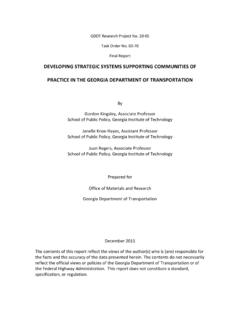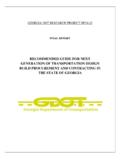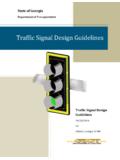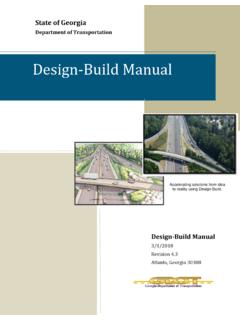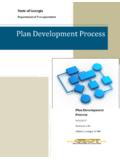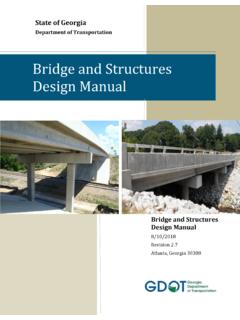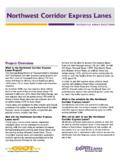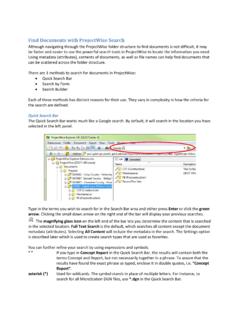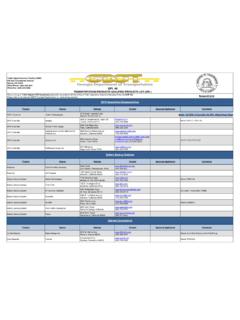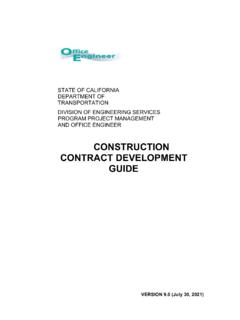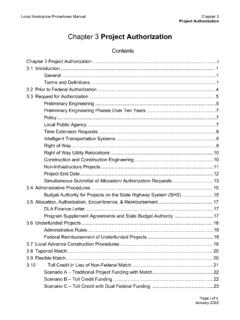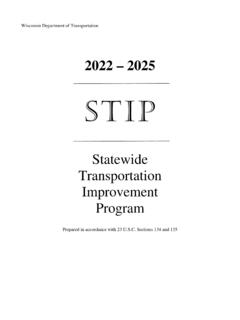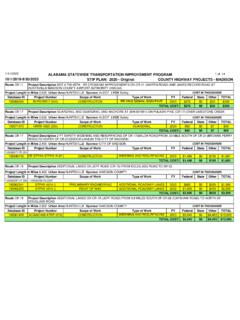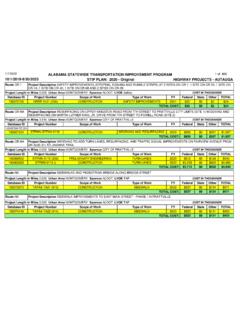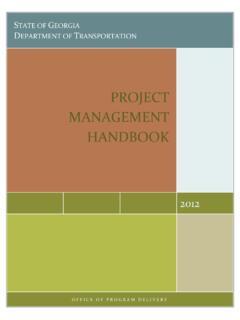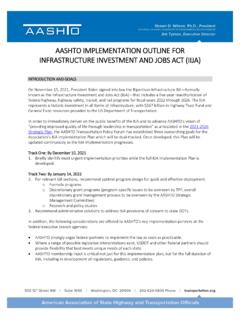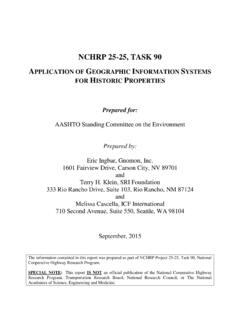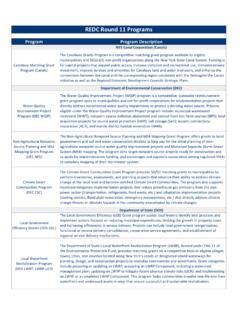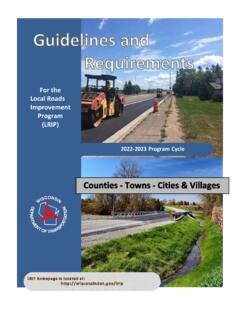Transcription of Design Traffic Forecasting Manual
1 Design Traffic Forecasting Manual 1/25/2018 Revision Atlanta, Georgia 30308 Design Traffic Forecasting Manual State of Georgia Department of transportation This document was developed as part of the continuing effort to provide guidance within the Georgia Department of transportation in fulfilling its mission to provide a safe, efficient, and sustainable transportation system through dedicated teamwork and responsible leadership supporting economic development, environmental sensitivity and improved quality of life. This document is not intended to establish policy within the Department, but to provide guidance in adhering to the policies of the Department.
2 Your comments, suggestions, and ideas for improvements are welcomed. Please send comments to: State Design Policy Engineer Georgia Department of transportation One Georgia Center 600 W. Peachtree Street, 26th Floor Atlanta, Georgia 30308 DISCLAIMER The Georgia Department of transportation maintains this printable document and is solely responsible for ensuring that it is equivalent to the approved Department guidelines. Design Traffic Forecasting Manual Page i Revision Summary Revision Number Revision Date Revision Summary 9/12/16 Revised and updated content; Reformatted entire Manual Changed section (Table 1). Added to Step 1 This form should be accurately and completely filled out and has to be submitted only ONCE for the entire Traffic Forecasting activities.
3 Changed section From During holiday periods when travel patterns are not routine . To During holiday periods when travel patterns are not routine (from a week before Thanksgiving to a week after New Year) Changed section / From During Traffic incidents ( crashes) that disrupt normal Traffic patterns . To During Traffic incidents ( crashes) that disrupt normal Traffic patterns 12/1/16 Changed section From Minimum 24 hour bi-directional counts .. To Minimum 48 hour bi-directional counts .. Changed section FROM For a proposed transportation improvement project on a major highway within an urbanized area, the MPO travel demand model can be used to help estimate growth rates from the base year to the future year.
4 Roadway improvement projects in rural areas outside MPO areas) will utilize the GSTDM to help estimate growth rates from the Base Year, the Base Year + 2 , the Design Year, and the Design Year + 2 conditions. The modeled volumes and estimated growth rates from the travel demand models should be compared and validated against current and historical Traffic counts. If there is a significant discrepancy between existing year model volumes and existing year counts, it is preferable to estimate a difference in volume using the model networks, and then add this difference to the base year volumes. TO For a proposed transportation improvement project on a major highway within an urbanized area, the MPO travel demand model can be used to help estimate growth rates for the future forecast conditions.
5 Roadway improvement projects in rural areas (outside MPO areas) will utilize the GSTDM to help estimate growth rates for the future forecast conditions. The estimated growth rates from the travel demand models should be compared to Design Traffic Forecasting Manual Page ii historical Traffic count trends from GDOT. Any significant discrepancy between growth rates estimated from model volumes and historical growth trends should be documented and properly accounted for in the future forecasts. Changed section (Table 4) FROM Minimum 24 hour bi-directional counts .. TO Minimum 48 hour bi-directional counts .. Changed Appendix E (Figure 6) Changed Appendix E (Figure 9) 11/15/17 Reformatted Manual to template 1/25/18 Chapter 6 Revised the list of Long Range transportation Plan (LRTP) Networks Design Traffic Forecasting Manual Rev.
6 List of Effective Chapters 1/25/18 Page iii List of Effective Chapters Document Revision Number Revision Date List of Effective Chapters 1/25/18 Table of Contents 11/15/17 List of Traffic -Related Acronyms 11/15/17 List of Traffic -Related Definitions 11/15/17 Chapter 1. Introduction 11/15/17 Chapter 2. Introduction to Design Traffic Forecasting 11/15/17 Chapter 3.
7 Overview of Design Traffic Forecasting Process 11/15/17 Chapter 4. Traffic Data Analysis for Design Traffic Forecasts 11/15/17 Chapter 5. Design Traffic Forecasting Process, Standards, and Documentation 11/15/17 Chapter 6. Design Traffic Forecasting Tools and Conventions 1/25/18 Chapter 7. Required Standards and Formats for Design Traffic Deliverables 11/15/17 Chapter 8. Design Traffic Reviews 11/15/17 Appendix A. Metropolitan Planning Organizations (MPOS) in Georgia (As Of 2015) 11/15/17 Appendix B. Example of Traffic Volume Reassignments for Non-Traditional Designs 11/15/17 Appendix C. Examples of Other Traffic -Related Deliverables 11/15/17 Appendix D.
8 Traffic Forecasts for Bike-Ped Projects 11/15/17 Appendix E. Traffic Forecasts for Bridge Projects 11/15/17 Design Traffic Forecasting Manual Rev. List of Effective Chapters 1/25/18 Page iv Intentionally Left Blank Design Traffic Forecasting Manual Rev List of Traffic -Related Acronyms 11/15/17
9 Page vii List of Traffic -Related Acronyms Listed below are some of the most common acronyms used by Traffic engineering practitioners. Additionally, there are several organizations noted that are excellent technical resources on Traffic engineering. Their website locations are noted as well. AADT Annual Average Daily Traffic AASHTO American Association of State Highway and transportation Officials ( ) AAWT - Annual Average Weekday Traffic ADA Americans with Disabilities Act ADT Average Daily Traffic AWT Average Weekday Traffic ATR Automated Traffic Recorder CWP (GDOT) Construction Work Program CORSIM Corridor Simulation Software DCD Double-Crossover Diamond DDI Diverging Diamond Interchange DLT Displaced Left-Turn DTE Designated Traffic Engineer E+C Existing plus Committed (Network) ETI Engineering Traffic Investigation (Report) FHWA Federal Highway Administration ( )
10 GDOT Georgia Department of transportation ( ) GLA Gross Leasable Area HCS Highway Capacity Software HCM Highway Capacity Manual HOV High Occupancy Vehicle ITE Institute of transportation Engineers ( ) ITS Intelligent transportation Systems LR Long Range LRTP Long Range transportation Plan LOS Level of Service MOE Measure of Effectiveness Design Traffic Forecasting Manual Rev List of Traffic -Related Acronyms 11/15/17 Page viii MPO Metropolitan Planning Organization MUT Median U-Turn MUTCD Manual on Uniform Traffic Control Devices PC/H Passenger Cars per Hour
